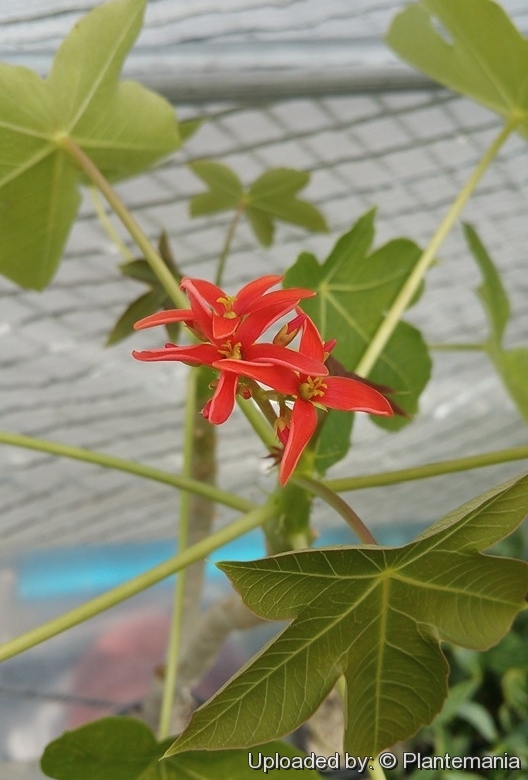




Your support is critical to our success.

Origin and Habitat: Jatropha macranthaSN|33652]]SN|33652]] is indigenous to the western slopes of the Andes, in central Peru, and can be found in abundance in the Marañon river valley (selva alta) and in the Amazon and in the Puno district in the localities of Ancash, Arequipa, Cajamarca, Huánuco, Lima, La Libertad y Puno (zonas alto andinas).
Altitude range: From 1500 to 2400 metres above sea level.
Habitat and ecology: This species grows among rocks in cactus desert together with Armatocereus procerusSN|4791]]SN|4825]], Armatocereus matucanensisSN|4825]]SN|4791]], Haageocereus acranthusSN|5512]]SN|5512]], Cleistocactus acanthurusSN|5479]]SN|5479]] var. faustianus, Cylindropuntia tuntcata, Echinopsis peruvianaSN|8637]]SN|8637]] and other succulent shrubs such as Carica candicans, Peperomia ssp., Pilea serphyllacea. There are also poikilohydric ferns (Cheilanthes and Pellaea), and, as well, Selaginella peruviana.
Synonyms:
- Jatropha macrantha Müll.Arg.
ENGLISH: Peruvian Viagra
SPANISH (Español): Barbasco (Peru), Guarnarpo Macho, Higos del Duende, Huanarpo, Huanarpo de Canta, Huanarpo Macho, Mitocala, Palo de Grado (Peru), Sangre de Drago (Peru), Simayuca, Urco Huanarpo (Peru), Vanarpo, Wanarpo, Huanarpo hembra
Description: The Huanarpo macho (Jatropha macranthaSN|33652]]SN|33652]]), is a slightly branched glabrous shrub sometimes a meter high, with pretty reddish-orange flowers in clusters on short succulent stalk. Its blooms appear during the dry period tardily and accompanied by the leaves which early are brownish and sticky as the sap of the fleshy branchlets, but in cultivation flowers are intermittently produced almost all year. It grows fast, and when planted in the open grows into a very pretty bush. The young rather phallic clubby branch stems of the huanarpo macho tree for centuries have been used in traditional medicine systems to support, aid, and enhance male sexual function.
Stem: Slightly branched up to 1(-2) m tall. Branches, few, glabrous, spreading, more or less fleshy, green when young, later with grey bark conspicuously marked by the callus-margined scars of the fallen petioles. The thick stems often become decumbent toward the base.
Leaves: Long petiolated, with a 3-lobed blade usually from near terminal ends of stems, 10-12 cm wide, 9-10 cm long, dark red when young, later glossy green, deeply cordate at base, the lobes broadly ovate, more or less imbricate, acute, entire. Stipules are reduced to sessile glands.
Inflorescences (cymes): Long stalked and richly branched. Peduncled short, the few large scarlet-red flowers capitately congested, the lower bracts leaf-like, ovate-lanceolate, acuminate, to 1 cm long
Flowers:Up to 2.5 cm in diameter with shiny red petals. Sepals of male flowers oblong-ovate, acute, glandular-dentate, free, 4-5 mm long. Petals to 20 mm long, oblong, obtuse, clawed, free. Glands distinct. Stamens 10, the outer shorter, the inner united forming a tube around the style. Ovary glabrous.
Bibliography: Major references and further lectures
1) James A. Duke “Duke's Handbook of Medicinal Plants of Latin America” CRC Press, 24 October 2008
2) Leslie Taylor “Huanarpo Macho (Jatropha macrantha)” web: http://www.rain-tree.com/huanarpo-macho.htm#.WIy5TtThBpS
3) Heinrich Walter, Siegmar-W. Breckle “Ecological Systems of the Geobiosphere: 2 Tropical and Subtropical Zonobiomes” Springer Science & Business Media, 29 June 2013
4) Werner Rauh “The Wonderful World of Succulents: Cultivation and Description of Selected Succulent Plants Other Than Cacti” Smithsonian Institution Press, 1984
5) “Fieldiana: Botany”, Volume 13, Field Museum of Natural History, 1951
6) Clive Innes “Complete Handbook of Cacti and Succulents” Van Nostrand Reinhold Company, 01 December 1981
7) Carlos Ostolaza “La Quebrada Tinajas” CACTUS & Co. 3 (1): 11-12, 1999
| Your Actions | |
|---|---|
| Back to Jatropha index | |
| Back to Euphorbiaceae index | |
 |
Back to Succulents Encyclopedia index |
Privacy stantement - Terms and conditions - How to cite - About us - Feedback - Donate



